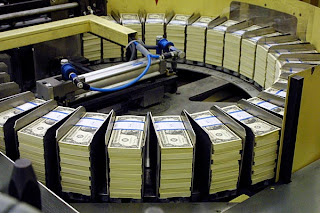How to Kickstart the Economy
By MIKE WHITNEY, originally published at CounterPunch
 On Friday, Fed chairman Ben Bernanke made the case for a second round of quantitative easing (QE) claiming that inflation is presently "too low" to achieve the Fed’s dual mandate of price stability and full employment. By purchasing long-term Treasuries, Bernanke hopes to lower bond yields and force investors into riskier assets. That, in turn, will push stocks higher, making investors feel wealthier and more apt to boost spending. (Re: "trickle down", when investors increase spending, it reduces the slack in the economy and lowers unemployment.) Thus, QE is intended to divert investment to where it is needed and to lift the economy out of the doldrums.
On Friday, Fed chairman Ben Bernanke made the case for a second round of quantitative easing (QE) claiming that inflation is presently "too low" to achieve the Fed’s dual mandate of price stability and full employment. By purchasing long-term Treasuries, Bernanke hopes to lower bond yields and force investors into riskier assets. That, in turn, will push stocks higher, making investors feel wealthier and more apt to boost spending. (Re: "trickle down", when investors increase spending, it reduces the slack in the economy and lowers unemployment.) Thus, QE is intended to divert investment to where it is needed and to lift the economy out of the doldrums.
That’s the theory, at least. In practice, it doesn’t work so well. Over a trillion dollars in reserves are still sitting on banks balance sheets from QE1. The anticipated credit expansion never got off the ground; the banks loan books are still shrinking. Bernanke fails to say why more-of-the-same will produce a different result. QE is also risky; in fact, it could make matters worse. Unconventional methods of pumping liquidity into the economy can undermine confidence in the dollar and trigger turmoil in the currency markets. Trading partners like Brazil and South Korea are already complaining that the Fed is flooding the markets with money pushing up their currencies and igniting inflation.
The threat of more cheap capital is causing widespread concern and talk of a currency war. If Bernanke goes ahead with his plan, more countries will implement capital controls and trade barriers. The Fed is clearing the way for a wave of protectionism. Quantitative easing, which is essentially an asset swap–reserves for securities–will not lower unemployment or revive the economy. Low bond yields won’t spark another credit expansion any more than low interest rates have increased home sales. The way to tackle flagging demand is with fiscal stimulus; food stamps, state aid, unemployment benefits, work programs etc. The focus should be on putting money in the hands of the people who will spend it immediately giving the economy the jolt that policymakers seek. QE doesn’t do that. It depends on asset inflation to generate more spending, which means that we’ve returned to the Fed’s preferred growth formula–bubblenomics.
Quantitative easing is also extremely costly for, what amounts to, modest gains. Consider this, from the Wall Street Journal:
"The Fed’s own internal models suggest that a purchase of $500 billion in Treasuries would only reduce the 10-year bond by something like 15 basis points….. This in turn would increase GDP by 0.2% a year and cut the jobless rate by 0.2%. That’s not much bang for a lot of bucks."
Bond yields fell more on Friday in reaction to Bernanke’s "jawboning", than they will when QE is actually implemented. That’s because Wall Street still thinks Bernanke has superhuman powers and can reverse severe deflation and mass deleveraging with a wave of his hand. But it’s not true. When households are repairing their balance sheets, they will not take on more debt regardless of how cheap money is, which is why credit will continue to grow at suboptimal levels. In a liquidity trap–when rates are already stuck at zero–interest rates become irrelevant.
Here’s a clip from Bernanke’s speech that points out the problem with QE:
"One disadvantage of asset purchases is that we have much less experience in judging the economic effects…these factors have dictated that the FOMC proceed with some caution in deciding whether to engage in further purchases of other long-term securities."
Isn’t this a tacit admission that Bernanke really doesn’t know what he’s doing? Remember, it was Bernanke, who, as late a July 2005, denied that there was a housing bubble. In 2007, Bernanke claimed that the subprime disaster was "contained". In 2008, Bernanke allowed Lehman Bros. to collapse rather than invoke the Fed’s "unusual and exigent" clause which he used willy-nilly for all of the Fed’s other so-called “emergency actions”. So, the Fed chairman already has a number of strikes against him, and now he wants to take the country into uncharted waters. This is not a decision that should be left to an unelected bureaucrat whose policies helped trigger the financial crisis.
The threat of deflation should be taken seriously, because once it becomes entrenched it can be difficult to root out. But there’s no need for experimentation; the remedies are already known (Keynesian stimulus) and have been used many times before with predictable success. The government needs to expand its budget deficits in order to provide sustained fiscal stimulus until household deleveraging ends and consumers can resume spending. The privately-owned banking system will not generate sufficient credit for another expansion because the banks are still impaired and consumers are huunkering down. It’s the government’s job to intervene and provide relief where it is needed.
Bernanke should align his bond-buying program with a second round of fiscal stimulus, preferably a two-year suspension of the payroll tax. Instead of inflating equities and commodities, the Fed’s liquidity would give the nation’s working people a well-deserved raise in pay that they’d use to kick-start the economy. That’s the best way to create demand and beat deflation.
Picture credit: Jr. Deputy Accountant


